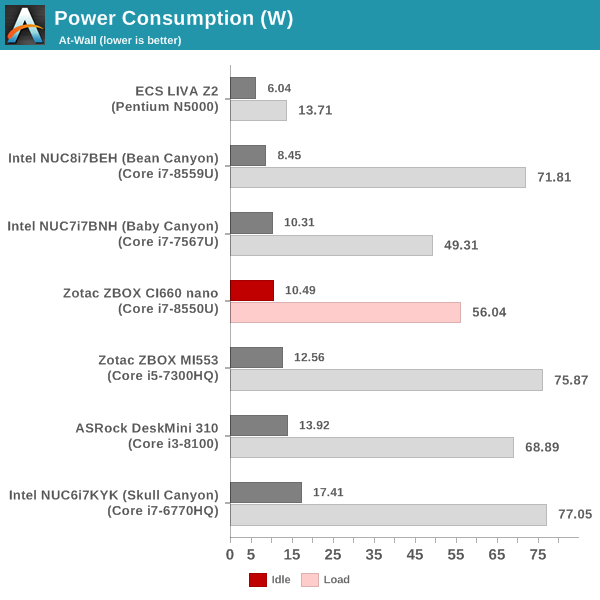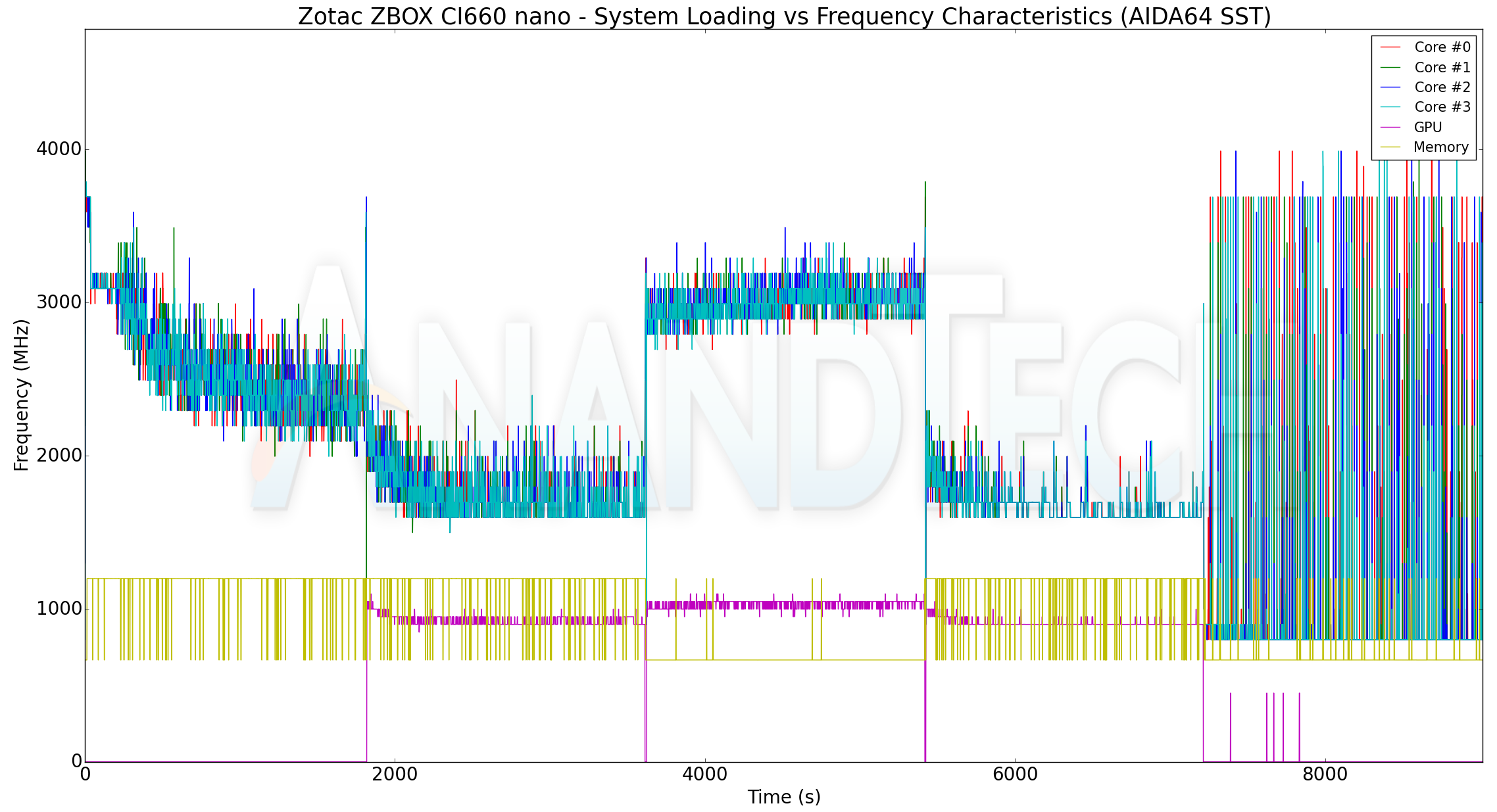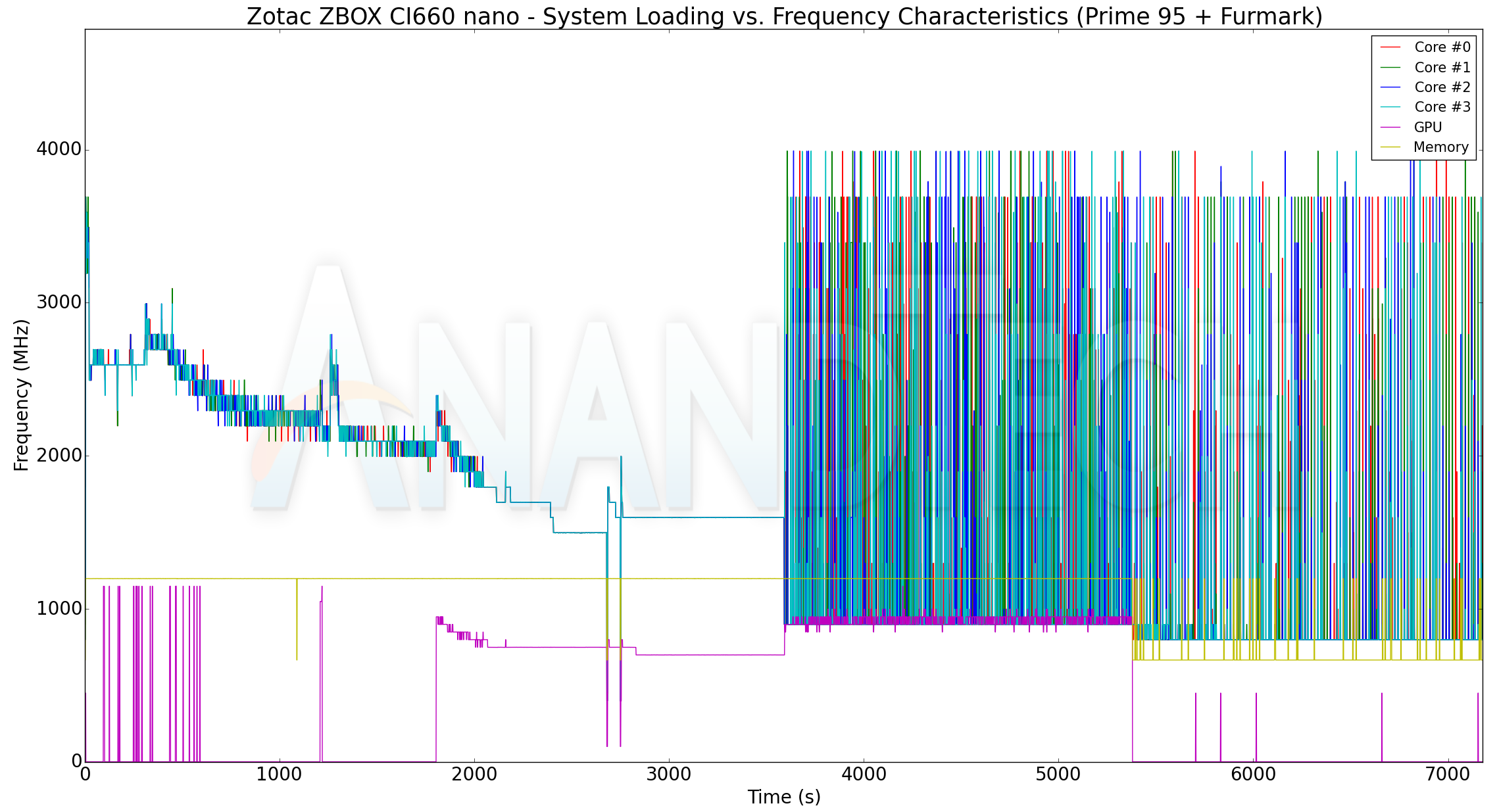The Zotac ZBOX CI660 nano Fanless mini-PC Review: A Promising HTPC Platform
by Ganesh T S on April 16, 2019 8:15 AM ESTMiscellaneous Aspects
The power consumption at the wall was measured with a 4K display being driven through the HDMI port. In the graphs below, we compare the idle and load power of the Zotac ZBOX CI660 nano with other low power PCs evaluated before. For load power consumption, we ran the AIDA64 System Stability Test with various stress components, and noted the maximum sustained power consumption at the wall.

As we see further down, instantaneous peak power consumption at the wall can go as high as 80W. The above numbers (particularly, the idle power consumption) are a tad high, given the fanless nature of the system. Other than that observation, the numbers go hand-in-hand with the system's capabilities.
Our thermal stress routine starts with the system at idle, followed by four stages of different system loading profiles using the AIDA64 System Stability Test (each of 30 minutes duration). In the first stage, we stress the CPU, caches and RAM. In the second stage, we add the GPU to the above list. In the third stage, we stress the GPU standalone. In the final stage, we stress all the system components (including the disks). Beyond this, we leave the unit idle in order to determine how quickly the various temperatures in the system can come back to normal idling range. The various clocks, temperatures and power consumption numbers for the system during the above routine are presented in the graphs below.
| Zotac ZBOX CI660 nano System Loading with the AIDA64 System Stability Test | |||

The Core i7-8550U has a base frequency of 1.8GHz, and can turbo up to 4 GHz. In the AIDA stress tests, we can see that processor maintains a minimum 1.8 GHz clock under all loading conditions. However, the same can't be said for our custom stress test which starts with Prime 95 for 30 minutes, followed by both Prime 95 and Furmark for 30 minutes, and ending with Furmark alone for another 30 minutes. Towards the middle of the second workload, we see the cores drop down to around 1.5 GHz in the graph below.
| Zotac ZBOX CI660 nano System Loading with Prime95 and Furmark | |||

The temperatures are the second item of interest. According to official specifications, the junction temperature of the Core i7-8550U is 100C. However, Zotac seems to have taken the safer route of throttling the performance as soon as the cores hit 85C. What does this throttling entail? The power graphs for the two cases above provide the answer.
The ZBOX CI660 nano initially sets out with the CPU package power allowed to go up to 25W. As soon as the temperature limit (85C) is hit, the permitted package power starts to track down. We find that the thermal solution is good enough to allow the package to operate at 15W while maintaining the package temperature at 85C.










23 Comments
View All Comments
jgraham11 - Tuesday, April 16, 2019 - link
BAPCo's SYSmark 2018 is an application-based benchmark that has been developed by Intel engineers for Intel CPUs and does not truly reflect performance of any real world application by any other chip vendor. The fact that every other chip maker have all abandoned Bapco's boards tell you something. This is a known conflict of interest that degrades Anandtech's credibility by highlighting it. At least in the past the articles, these conflicts were pointed out regarding Bapco's shaky past.Daeros - Tuesday, April 16, 2019 - link
Anandtech's quality has been on a continuous downward slide, including increasing Intel/Nvidia bias, ever since Anand left. The site looks and sounds like it's written by children now - especially including comments the editorial staff post in comments sections and on twitter.Eris_Floralia - Tuesday, April 16, 2019 - link
Hey what about my AndreiDigitalFreak - Tuesday, April 16, 2019 - link
While I would agree that the quality is not near as good as it was when Anand was around, I don't see any bias.PeachNCream - Thursday, April 18, 2019 - link
Read literally anything written about a Killer NIC.rrinker - Tuesday, April 16, 2019 - link
Seems like this article only compares Intel systems to other Intel systems - so what's the problem? Other than, of course, this article does not agree with some personal bias of yours, therefore all of Anandtech is now not credible, etc. A little extreme reaction don't you think? But such is the way witht he extremism in EVERYTHING these days. Social media has destroyed any chance for critical thinking. Anandtech does an article that's positive towards Intel, OMG BIASED, They hate AMD. They write a different article that's positive towards an AMD product - OMG BIASED! Why the hate on Intel?Irata - Tuesday, April 16, 2019 - link
Yup, using a benchmark by Bapco in which no chip company besides Intel seems to have confidence does leave a rather bad taste.nVidia, AMD and VIA all left the consortium back in 2011 and prior to that Bapco was found to have modified their benchmarks in a way that favored Intel CPU
Ryan Smith - Wednesday, April 17, 2019 - link
SYSmark 2018 is one of several tools we use in this article. It is certainly not the only tool we use, and it's not a tool we use in all situations (e.g. architecture deep dives). Meanwhile for SFF PCs in particular, its power measurement capabilities are pretty handy to have. Plus the only other systems we're comparing it to are all Intel-based anyhow.MDD1963 - Thursday, April 18, 2019 - link
If BAPCO SYSMark was developed by Intel engineers, this would seem more an issue if/when comparing Intel systems to AMD, and not really an issue when comparing all Intel systems...mammothboy - Tuesday, April 16, 2019 - link
The Realtec NICs may be a blessing for use with Windows Server (Intel has a nasty habit of not providing drivers for many of their NICs). Having two will let you set up a team there (perhaps to use as a AD/DNS server) or use as a firewall/router (not that I'd use Windows Server for either).I've generally had good luck with Realtec with Windows Server and PFSense.